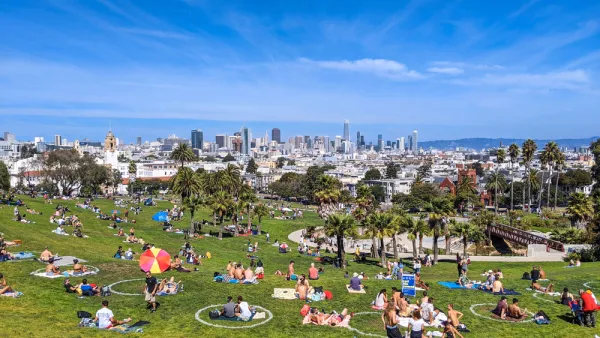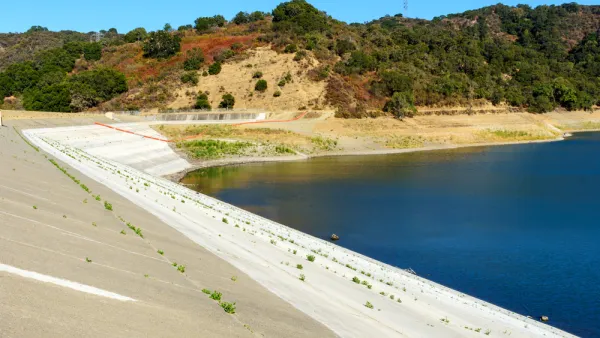Reviewer Jon Christensen suggests that an alternative title to this book on urban economic development by four UCLA researchers could be the much simpler, and probably more attention-grabbing, "How San Francisco Beat L.A. — for Now Anyway."

"This is a very serious new book [published by Stanford Press] about economics and policy written by a team of academics under the leadership of Michael Storper," a professor of urban planning at UCLA Luskin School of Public Affairs, writes Jon Christensen, adjunct assistant professor in the Institute of the Environment and Sustainability, UCLA.
The mystery is why the Bay Area and Greater Los Angeles metropolitan regions, which were essentially similar by many important measures in 1970 — especially real household incomes, but also innovation, investment, education and creative jobs — have diverged so dramatically in the years since. The Bay Area has continued to rise in the top ranks of metropolitan areas and now enjoys real average household incomes (minus housing costs) 50 percent higher than Los Angeles....
Simply put, "the Bay Area definitely won the 'new economy'. And L.A. lost it.," writes Christensen. But why? After careful examination of a flurry of factors, Storper and his co-authors arrive at "the provocative and persuasive conclusion that the answer is the 'zeitgeist,' cultures of business, policy and governance that differ significantly between the two regions."
An “open source culture” in the Bay Area enabled more open paths of movement and trade of people, ideas and capital between firms... By contrast, in Los Angeles, a top-down, “big dog” culture prevailed in business and government....
Surprisingly, they find that "(t)he Bay Area also has a deeper, more self-conscious history of regional thinking." A recent post suggests that San Francisco housing advocates should sue the suburbs for their lack of effort in providing affordable housing.
Researchers also credit "business and civic leaders such as the Bay Area Council (for) relentlessly beat(ing) the drum for the region’s 'interconnected innovation system,' the importance of human capital as well as venture capital, and the shared vision of creating a high-wage, high-skill economy," writes Christensen. The Council was also the primary advocate in the 1950s for a regional rail line that turned into BART. More recently, they were the major backer of a new regional ferry system.
While L.A. was "focused much more on trying to keep light manufacturing in the city, reduce business and development costs, and improve the vast logistics and transportation system around the ports in San Pedro and Long Beach,' the Bay Area took the 'high road' of the 'new knowledge economy, stressing technology, innovation and skills,' Storper and colleagues write," observes Christensen. "Los Angeles took the 'low road' and has paid the price."
“Los Angeles leadership persisted in believing they could turn back the clock and become cheaper, and by traveling this low road they could hence compete with Texas, Alabama, and Mexico,” the authors write.
While the Bay Area has “outperformed most metropolitan areas” in the United States, the authors write, “Los Angeles has foundered.” Among all of the major metropolitan areas in the country, they add, Los Angeles now “most closely resembles Detroit.”
The three other authors are:
- Thomas Kemeny, Department of Public Policy at UNC Chapel Hill, (Ph.D. in Urban Planning from the University of California–Los Angeles).
- Dr Naji Makarem, Urban Economic Development program, University College London, PhD in Urban Planning from UCLA.
- Taner Osman, post-doctoral researcher and an instructor in the Department of Urban Planning at the University of California, Los Angeles.
Jon Christensen is an adjunct assistant professor and Pritzker fellow in the Institute of the Environment and Sustainability and the Department of History at the University of California, Los Angeles. He has been an environmental journalist and science writer for 30 years. He also was executive director of the Bill Lane Center for the American West, an interdisciplinary center for research, teaching, new media and journalism at Stanford University before moving to UCLA.
FULL STORY: ‘The Rise and Fall of Urban Economies'

Analysis: Cybertruck Fatality Rate Far Exceeds That of Ford Pinto
The Tesla Cybertruck was recalled seven times last year.

National Parks Layoffs Will Cause Communities to Lose Billions
Thousands of essential park workers were laid off this week, just before the busy spring break season.

Retro-silient?: America’s First “Eco-burb,” The Woodlands Turns 50
A master-planned community north of Houston offers lessons on green infrastructure and resilient design, but falls short of its founder’s lofty affordability and walkability goals.

Test News Post 1
This is a summary

Analysis: Cybertruck Fatality Rate Far Exceeds That of Ford Pinto
The Tesla Cybertruck was recalled seven times last year.

Test News Headline 46
Test for the image on the front page.
Urban Design for Planners 1: Software Tools
This six-course series explores essential urban design concepts using open source software and equips planners with the tools they need to participate fully in the urban design process.
Planning for Universal Design
Learn the tools for implementing Universal Design in planning regulations.
EMC Planning Group, Inc.
Planetizen
Planetizen
Mpact (formerly Rail~Volution)
Great Falls Development Authority, Inc.
HUDs Office of Policy Development and Research
NYU Wagner Graduate School of Public Service




























